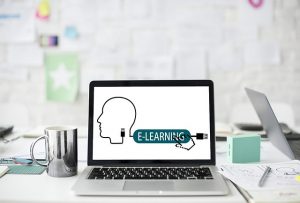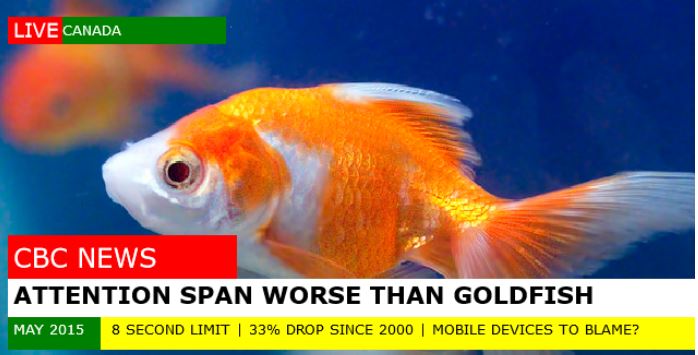Phases of Cognitive Development: Learning Loop
By zeroing in on the four phases of cognitive development from CoI’s Teaching Presence sphere, we can use them to frame the resources we include in modules developed through Open at Scale. Together, providing 1) a hook or springboard to pique interest, 2) material to explore, 3) opportunities to integrate new information, and 4) a prompt to reflect or resolve outstanding issues, can engage learners more deeply with the content and foster a more meaningful connection with the material.

Pique interest
Jumpstarting each activity with a Springboard or Hook piques learners’ interest. It might be as simple as a quote that highlights the relevance of the concept or an infographic or news article that shines a spotlight on an issue or content. Other popular springboards include a short video or quick game. You could also create a springboard that provides a glimpse of what’s to come in the module. For example, each module could lead off with a quick, diagnostic quiz pulling ideas and concepts covered in the module. It grounds learners in the module and alerts them to participate actively in order to acquire a mastery of core concepts.
Springboard example
Piquing through templating
Underscoring the relevance and importance of the module can also act as a Springboard. For the Open at Scale projects, an aim is a consistent look and feel to the modules. To that end, Open at Scale projects require that each chapter opens by stating learning outcomes and underscoring the relevance of the information and learning required in the module. A similar requirement is that each activity or module be closed. For example:
Learning outcomes
By the end of the chapter, you should be able to:
- Define entrepreneur and describe the three characteristics of entrepreneurial activity.
- Identify five potential advantages to starting your own business.
- Define a small business and explain the importance of small businesses to the Canadian economy.
- Explain why small businesses tend to foster innovation more effectively than large ones.
From here, learners have clear expectations and are primed for key concepts before they begin. There is the added benefit of tying this content to the larger program standards or professional standards and ultimately the career and/or academic goals of your learners, underscoring relevance and applicability.
Explore
The Explore phase provides opportunities for learners to dig into the topic, concept, or theme. As always, you will consider learners’ different preferences and accommodations. Where possible, providing material in multiple formats is a wonderful boost, ensuring that Universal Design for Learning (UDL)/Inclusive Design principles are in place and learners’ opportunities are maximized.
The Explore phase is traditionally the information formerly provided by the Subject Matter Expert (SME) in the form of PowerPoints and/or lecture notes. Given that this information tends to be mined from the fee-based resource assigned for the course, it will likely take some time and talent to curate or create alternate, open resources. Luckily, the Open Access movement has freed much more information into the open.
Considerations
CBC News. (2015, May 17). Canadians’ attention span worse than the average goldfish. Retrieved from https://www.cbc.ca/news/canada/canadians-attention-span-worse-than-the-average-goldfish-1.3077646
Even if you don’t believe circumstances to be as dire as the above article suggests, it’s a good plan to avoid pages and pages of text with little to no variation. Luckily, harnessing basic technology to inject interest and activity into what would otherwise be pages of text is easily facilitated. A healthy balance of READ + WATCH + LISTEN + DO will engage your learners, allow you to express more of your creativity, and use educational technology tools to their full potential.
Just as you may restate concepts in multiple ways to solidify understanding in your structured class time, presenting “textbook” information in multiple ways assists the process of learning more independently.
Deeper dive: The science of eLearning

Whether you are creating or curating multimedia resources to complement text, be on the look out for high-quality, impactful resources. Since you are able to inject technology into learning environments like never before, it is easy to overload learners. Richard E. Mayer and Ruth C. Clark, with their decades of experience in educational and instructional psychology research, continue to contribute to a science of eLearning. Their principles can guide your curation and creation of multimedia elements.
Below is a distillation of some of their key findings for fledgling online learning environments. Think of it as a crib sheet for your multimedia.
Some design principles:
Show what you know!
Integrate
This third phase of cognitive development, Integrate, often goes hand in hand with Explore. From their explorations, learners connect new ideas and begin to address the cognitive dissonance or challenges they faced while investigating and exploring during phase two. As your learners are working independently with this resource, you will not be there to prompt and probe organically. Any expectations for your learners to integrate new material must be clearly defined.
Integration may be as simple as using shaded text boxes to periodically stop the flow of text and inject a challenge question, point to ponder, or a link to additional resources. See the chapter template for guidance on how Open at Scale resources will facilitate integration.
Reflection and resolution

This phase, more than the others, is usually tied to more formal or summative assessments. However, it is still good practice to prompt students to reflect and/or resolve any cognitive dissonance, lingering questions, or muddy areas. This is also the most often neglected phase; reflection and resolution often only come into play in assessment, thereby not providing learners opportunities to practise reflection/resolution before being required to perform it for evaluation.
Facilitating opportunities for reflection and resolution require finding an appropriate tool to capture and communicate the reflection:
- hypothes.is, a collaborative note-taking and annotation tool, can boost reflection.
- Using H5P’s Documentation tool to more formally record connections, extensions, and clarifications is another option.
- Embedding other tools like Google Form can close the learning loop.
- Including a Key Takeaways section at the end of each chapter/module can lead to students reflecting or resolving outstanding issues e.g., gaps in knowledge.
An example of the second bookend, Key Takeaways, that will conclude each module/chapter created as part of Open at Scale:
Key takeaways
This also acts as the second bookend.
- Just as the Learning Outcomes ‘set the scene’ by communicating expectations and aligning to the discipline’s larger goals, Key Takeaways wrap the activities and content.
- Key Takeaways prompt the learner to confirm that they understand the module/chapter content and link back to the Learning Outcomes.
- Providing a thoughtful, cohesive collection of content and activities for learners assists by modeling a learning loop that they can replicate.


